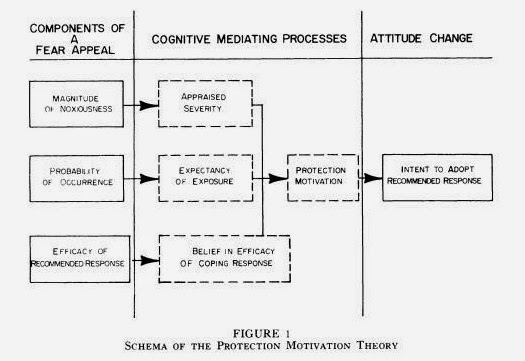This mouthwash advert is a prime example of a fear appeal.
The purpose of such appeals is to induce fear and anxiety associated with a
particular outcome and then offer a means of preventing this outcome, thus
resulting in the individual’s intention to adopt the preventative measure in
order to reduce these undesirable feelings.
Protection Motivation Theory (Rogers, 1975) aims to explain how such fear communications work by proposing three critical components: (a) the perceived severity of an event, (b) the probability of said event’s occurrence and (c) the efficacy of a protective response. These components are said to initiate corresponding cognitive processes which mediate attitude change. This theory is summed up in the figure below.
This advert satisfies the three components of PMT by postulating:
(a)
A high severity outcome associated with gum
disease i.e. losing one’s teeth
(b)
A high probability outcome, as gum
disease is the leading cause of tooth
loss.
(c)
A high efficacy protective response i.e.
use Corsodyl mouthwash which is clinically
proven to treat gum disease
PMT theory has been found to be effective in encouraging
attitude change in various domains. For example, in one study by Stainback and
Rogers (1983), fear appeals were used as a means of preventing underage drinking. In this study, persuasive messages
were created by manipulating the descriptions of the severity of consequences
of drinking alcohol (severe vs. not severe) and the probability of occurrence
(high probability vs. low probability) of these consequences. The efficacy of the
coping response was held constant across conditions as the participants (9th
graders) were told that abstinence was the best way to avoid the negative consequences
associated with teenage drinking. Immediately after receiving this information,
the high fear group (severe consequences with high probability) expressed
stronger intentions to remain abstinent than the low fear group (no
consequences with low probability).
Therefore, it can be seen
that an effective way to produce a change in behaviour, or at least in
intention, is to convince people of the serious negative consequences which are
highly likely to occur if they do not adopt a recommended course of action
(i.e. If you do not use this mouthwash, gum disease will almost definitely cause
your teeth to fall out).
References:
Rogers, R. W. (1975). A
protection motivation theory of fear appeals and attitude change. Journal of
Psychology, 91, 93-114.
Stainback, R.D., &
Rogers, R.W. (1983). Identifying effective components of alcohol abuse
prevention programs: Effects of fear appeals, message style and source
expertise. International Journal of Addictions, 18, 393-405.


No comments:
Post a Comment
Note: Only a member of this blog may post a comment.